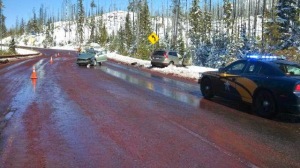
The NHTSA, or National Highway Traffic Safety Administration, is the governmental organization in charge of monitoring, proposing, and enforcing road safety policy throughout the United States. There are a great many things they get right, including their position that the approximately 35,000 people who die each year in the US shouldn’t be dying.
However, there are also points they miss due to an overfocus on the United States as a unique entity…
and not simply as one of many wealthy countries interested in increasing road safety with the potential to learn from other wealthy countries. A recent NPR article discussed Vision Zero, the NHTSA, and our slowly changing climate of road safety. Let’s look at it together, as well as the most significant things that were and weren’t said.
Zero. That’s the stated goal of transportation officials in the U.S., no traffic fatalities by 2046. Zero deaths is a movement that began in Sweden. There, it’s called Vision Zero. The idea is simple. “No loss of life is acceptable.” That is the one sentence motto of Sweden’s campaign.
The opening paragraph nicely summarizes both Vision Zero…
which I’ve discussed in multiple prior articles, and the US’ current take on it, which aims for zero traffic deaths 30 years from now. That’s much later than I’d like to see the goal, but it’s at least a start to have a goal, and to have it relatively soon in the future. The Vision Zero mentality is where we have to begin, after all, with the idea that no deaths are acceptable, and that all lives are valuable.
One of the tragic coincidences is that as economic activity increases and more people with jobs are on the road, traffic fatalities go up. U.S. drivers put in a record 1.58 trillion miles on the road in the first half of this year, the Federal Highway Administration said this week. That’s a 3.3 percent increase over the same period in 2015. Meanwhile, the rate of deaths is up by more than 10 percent.
This is old news in the auto safety world, but it’s always new to normal folks;
…the more you drive, the greater your odds are of being involved in a collision, fatal or otherwise.
There are plenty of reasons to drive less, whether from ecological, financial, familial, or spiritual reasons, but one of the most basic reasons to drive less should be because the less you drive, the safer you are. It’s a lot cheaper than buying the latest and greatest technology, too.
“The really sad part is that in the United States we accept 35,092 people dying on the roadways and thinking that’s okay. It should be unacceptable,” says Mark Rosekind, the head of NHTSA. Rosekind’s father was a motorcycle policeman in San Francisco, who was killed on the road in the line of duty. “There are too many stories like this,” Rosekind says.
I completely agree with Mark Rosekind here; the subtitle of this blog has to do with those 35,000 people and how to avoid you or our loved ones joining them each year. If you’re reading this blog, or any information related to car seat safety or auto safety in general, you’re already ahead of the game, because most people aren’t reading this kind of information and most people have no idea how much of a bloodbath our roads are.
The truth is that our annual traffic statistics are the equivalent of a 9/11 every month on the roads, over and over and over again.
This isn’t something that comes up during the elections; you won’t hear President Obama or Trump talking about 35,000 fatalities each year, even though your odds of dying in a car crash are thousands of times higher in the US than your odds of dying in a terrorist attack. It’s not attractive news; it doesn’t sell papers. But it’s real.
Practically, getting to zero is not only an ambitious goal, but a complex one as well. In Sweden, a premium is placed on safety over convenience, traffic or speed. Low urban speed limits, strict policing of drunk driving, bike lanes with barriers separating cyclists from traffic, and smart pedestrian crossings are some of the solutions implemented.
This is absolutely true; however, it underemphasizes a crucial point–
The speed limits are a huge, huge part of the equation.
Yes, the separated cycling traffic is significant (best practice suggests people in cars and people not in cars shouldn’t mix when road speeds can surpass 20 mph). Yes, cultural abhorrence of drunk driving is important (the blood alcohol limit there is .02%, compared to the boozehound limit of .08% in the US). However, the recognition and implementation of road design and speed limits in concert with the physiological tolerances of the human body make up the majority of the equation. There are speeds the human body can’t survive. Keep traffic below them, and you keep people alive. It’s as simple as that if we want it to be.
“There isn’t actually a single magic bullet. It’s not like you can say if the entire country just changed its speed laws then we’d get rid of all fatalities on the road,” Rosekind warns.
This is where Rosekind goes off track. Technically, he’s right that we wouldn’t eliminate every traffic fatality by lowering speed limits; there’d still be the occasional freak accident here and there.
But there’s a reason why most fellow rich countries have sliced their roadway fatalities…
by an average of close to 75% in the last fifteen years while the US has only dropped by around 33%, and it’s not because all the other countries are keeping cyclists away from drivers; the primary reason has to do with following Vision Zero speed limits in roadway design. The longer we make excuses for a fundamental error in roadway design throughout the country, the longer we’re going to suffer tens of thousands of needless deaths year after year.
The next time you drive on an undivided roadway with a speed limit above 45 mph, know that you’re driving on a road that wouldn’t exist in Sweden. The next time you drive through a city with a speed limit above 30 mph, know that you’re driving on a road that wouldn’t exist in Norway. The next time you drive through a neighborhood or past a cyclist at more than 20 mph, know that you’re driving on a dinosaur-age level of road design that’s going extinct around the world. These are unsafe designs, and we need to get rid of them if we really want to get rid of road deaths. Everything else is just taking the long, winding, and potentially useless way home.
 If you find my information on best practices in car and car seat safety helpful, you can do your shopping through this Amazon link. Canadians can shop here for Canadian purchases. Have a question or want to discuss best practices? Join us in the forums!
If you find my information on best practices in car and car seat safety helpful, you can do your shopping through this Amazon link. Canadians can shop here for Canadian purchases. Have a question or want to discuss best practices? Join us in the forums!



 Higher speed limits, like an entire bag of Hershey’s Kisses, are one of those things that sound good but really aren’t good for you. Politicians love them because they know people won’t oppose them. After all, who would object to being able to speed a bit more on the highway? It’s something we all do anyway, right?
Higher speed limits, like an entire bag of Hershey’s Kisses, are one of those things that sound good but really aren’t good for you. Politicians love them because they know people won’t oppose them. After all, who would object to being able to speed a bit more on the highway? It’s something we all do anyway, right?
